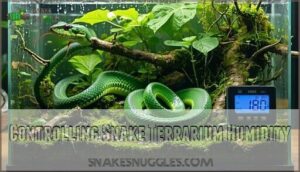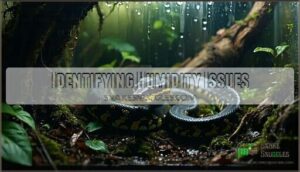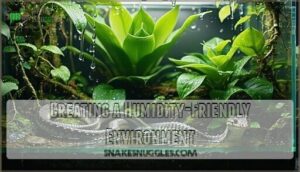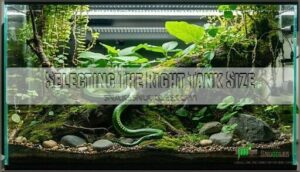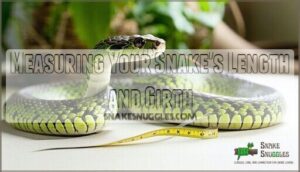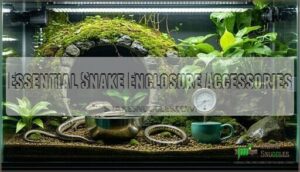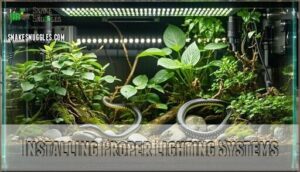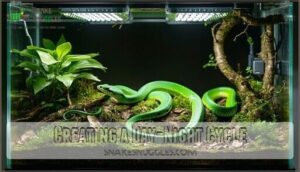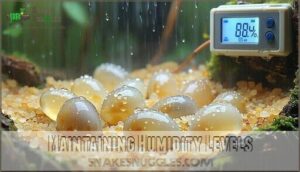This site is supported by our readers. We may earn a commission, at no cost to you, if you purchase through links.
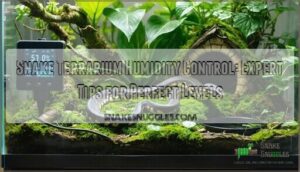 Mastering snake terrarium humidity control doesn’t have to feel like rocket science.
Mastering snake terrarium humidity control doesn’t have to feel like rocket science.
You’ll want to grab a reliable hygrometer first—think of it as your humidity detective.
Most snakes thrive between 50-60% humidity, but ball pythons need it cranked up to 60-80%.
Control levels by adjusting your water bowl size, switching substrates (cypress mulch holds moisture, aspen doesn’t), and tweaking ventilation.
Too dry? Add a humid hide with damp moss.
Too muggy? Increase airflow or use a smaller water dish.
Your snake’s shedding quality tells the real story—perfect sheds mean you’ve nailed the balance.
But there’s more to this humidity puzzle.
Table Of Contents
- Key Takeaways
- Choosing The Right Snake
- Controlling Snake Terrarium Humidity
- Identifying Humidity Issues
- Creating a Humidity-Friendly Environment
- Setting Up a Snake Tank
- Heating and Lighting Options
- Maintaining Humidity Levels
- Managing Humidity With Lighting and Heating
- Water Management for Lower Humidity
- Monitoring and Adjusting Humidity
- Frequently Asked Questions (FAQs)
- How to control humidity in a snake enclosure?
- How do I lower the humidity in my terrarium?
- Is 70% humidity too high for a corn snake?
- Is 50% humidity okay for a ball python?
- How do you lower humidity in a snake vivarium?
- How do I maintain humidity in my snake tank?
- Do snake enclosures need a humidifier?
- How to control humidity in a snake habitat effectively?
- How much humidity does a snake need?
- How do you keep a snake cool in a terrarium?
- Conclusion
Key Takeaways
- You’ll need a reliable digital hygrometer to monitor humidity levels accurately – most snakes thrive at 50-60% humidity, but ball pythons require 60-80% for proper health and shedding.
- Control humidity by adjusting water bowl size, choosing the right substrate (cypress mulch retains moisture while aspen doesn’t), and managing ventilation to prevent stagnant air pockets.
- Watch your snake’s shedding quality as the ultimate indicator – perfect sheds mean you’ve nailed the humidity balance, while stuck shed pieces signal you need adjustments.
- Create strategic dry and humid zones by positioning heat sources properly, adding humid hides with damp moss for moisture, and using smaller water bowls when humidity gets too high to maintain a proper health and ensure perfect sheds.
Choosing The Right Snake
You’ll find that picking the right snake makes humidity control much easier, especially when you choose beginner-friendly species like corn snakes or spotted pythons that won’t make you pull your hair out.
Snake humidity shouldn’t feel like rocket science—pick the right species and watch your stress levels plummet along with your learning curve.
These adaptable reptiles handle humidity changes better than their finicky cousins, so you can focus on learning the basics without worrying about creating a perfect rainforest in your living room, which is a significant advantage when dealing with humidity control.
Beginner-Friendly Snake Species
When you’re starting your snake journey, choosing the right species makes all the difference. Docile Snake Breeds like Spotted Pythons and Corn Snakes are perfect Low Maintenance Snakes that won’t overwhelm you with complex snake terrarium humidity needs.
Adaptable Snake Species handle humidity control mistakes gracefully while you’re learning. Here’s what makes these beginnerfriendly snakes special:
- Spotted Python: Reaches only 100cm with a gentle Snake Temperament that’s perfect for Handling Beginner Snakes
- Children’s Python: Beautiful sheen meets straightforward care requirements
- Corn Snake: Thrives in various humidity levels while maintaining excellent snake health
These species forgive rookie mistakes while you master proper care techniques. Many beginners find success with snakes that have calm and hardy nature.
Factors to Consider When Selecting a Snake
Beyond picking a beginner-friendly snake, you’ll need to take into account species temperament, size potential, and care requirements.
Match your experience level with the snake’s personality – docile species work best for newcomers.
Think about your space constraints too. Some snakes grow massive while others stay compact.
Most importantly, research each species’ humidity needs since snake terrarium humidity control varies dramatically between different snake species and their specific humidity requirements.
Controlling Snake Terrarium Humidity
Managing your snake’s humidity feels like conducting an orchestra – every element must work in harmony.
When your snake’s world is perfectly balanced, they’ll show you with smooth sheds and stress-free behavior.
Proper snake terrarium humidity control keeps your reptile healthy and comfortable. Here’s your roadmap to mastering humidity control methods:
- Install reliable humidity tools like digital hygrometers for accurate monitoring
- Choose appropriate substrate options that match your snake’s natural habitat needs
- Master misting techniques with lukewarm water twice daily
- Implement ventilation strategies using strategic vent placement for ideal airflow
These reptile enclosure humidity basics guarantee perfect snake humidity levels.
Identifying Humidity Issues
You’ll know when your snake’s humidity isn’t quite right because they’ll show you clear warning signs, like a stubborn shed that won’t come off or mysterious condensation fogging up the glass walls.
Think of yourself as a humidity detective – you’re looking for clues like mold growth, dull scales, or your snake spending way too much time rubbing against rough surfaces, which can be a clear sign of discomfort, making you a detective.
Signs of High Humidity
Humidity-overload creates unmistakable warning signs that’ll make your snake’s home feel more like a swamp than a sanctuary.
Here’s what screams "too much moisture":
- Mold growth appearing as fuzzy patches on surfaces, substrate, or decorations
- Condensation buildup forming persistent water droplets on glass walls and lid
- Damp substrate that stays soggy and never properly dries out between mistings
- Musty odor filling the enclosure, indicating humidity problems that can trigger scale rot and respiratory issues
These red flags mean it’s time to dial back your moisture game before serious health complications develop.
Signs of Low Humidity
Spotting low humidity problems requires watching your snake’s behavior and appearance closely.
You’ll notice incomplete sheds where skin peels off in stubborn patches instead of one smooth piece.
Your snake starts skin rubbing frantically against decorations, desperately trying to remove stuck scales.
Wrinkled scales appear dull and lifeless, while behavioral changes include camping near the water bowl—classic dehydration signs demanding immediate snake terrarium humidity control adjustments.
Health Risks of Extreme Humidity
When humidity levels swing too far in either direction, your snake’s health takes a serious hit.
High humidity creates perfect conditions for scale rot – those nasty bacterial infections that show up as fluid-filled blisters.
Respiratory infections follow close behind, making breathing difficult.
Meanwhile, chronic dehydration from low humidity can permanently damage organs, turning your pet’s world upside down.
Creating a Humidity-Friendly Environment
You’ve spotted the warning signs, so now it’s time to build the perfect moisture haven your snake actually wants to call home.
Think of it like setting up a cozy spa retreat, where the right substrate, smart water placement, and temperature control work together to keep your scaly friend comfortable and healthy.
Choosing The Right Substrate
Your substrate selection can make or break humidity control in your snake’s home.
Coconut fiber and cypress mulch excel at moisture retention while mimicking your snake’s natural habitat. For drier environments, aspen shavings work perfectly.
Consider your species needs – ball pythons love humidity-retaining substrates, while corn snakes prefer drier options. Coconut fiber substrate is a popular choice for reptile enclosures.
Proper substrate depth and choosing substrate options that prevent mold prevention keeps your slithery friend healthy and comfortable.
Managing Water and Misting
Once you’ve got your substrate sorted, water becomes your humidity game-changer. Strategic water placement away from heat sources prevents excessive evaporation and maintains steady moisture levels.
A quality terrarium misting system transforms your setup from guesswork to precision. Here’s what really matters:
- Position water bowls at the cool end for controlled water vaporization
- Adjust misting frequency based on your hygrometer readings
- Use distilled water in your misting system to prevent mineral buildup
- Monitor water quality weekly – dirty water affects both health and humidity
To guarantee accuracy, use reliable digital hygrometers for monitoring humidity. Smart frequency adjustment keeps your snake comfortable year-round.
Regulating Temperature
In the context of snake terrarium humidity control, your heat source choices make all the difference.
Think of temperature gradients as your secret weapon – they create natural air circulation that prevents stagnant, overly humid pockets.
- Heat lamps establish dry basking spots while promoting airflow
- Ceramic heaters deliver consistent warmth without moisture interference
- Thermostat control prevents overheating that crashes humidity levels
- Temperature gradients encourage proper air movement throughout the terrarium
- Nighttime temperatures should drop slightly to maintain natural cycles
Setting Up a Snake Tank
You’ll want to choose a tank that’s spacious enough for your snake to stretch out completely, which means planning for about one square foot of floor space per foot of snake length.
Don’t forget the essential accessories like hides, a reliable water bowl, and a digital hygrometer to track humidity – think of these as your snake’s version of furniture that actually serves a purpose.
Selecting The Right Tank Size
Tank size isn’t just about fitting your snake—it’s about giving them room to thrive.
Your snake terrarium should provide 2/3 to 1 square foot of floor space per foot of snake length.
Consider your pet’s growth rate and long-term needs when selecting tank material and dimensions.
A cramped enclosure leads to stress, while proper tank size guarantees your snake can stretch, explore, and maintain healthy behaviors throughout their life.
Measuring Your Snake’s Length and Girth
Since your snake’s size directly impacts their snake terrarium humidity needs, monthly measurements are vital for proper Growth Monitoring and Health Assessment.
Use a soft measuring tape to track length from nose to tail, then measure girth around their widest point.
- Length tracking – Gently stretch your snake along a flat surface for accurate readings
- Girth measurement – Wrap tape around mid-body section where they’re thickest
- Growth documentation – Record measurements to guarantee appropriate Enclosure Size and ideal humidity control conditions
Essential Snake Enclosure Accessories
After measuring your snake’s dimensions, you’ll need the right gear to create a thriving home.
Every snake terrarium requires specific accessories for proper humidity control.
| Accessory Type | Purpose | Humidity Impact |
|---|---|---|
| Hides and caves | Security and comfort | Retains local moisture |
| Water bowls | Drinking and soaking | Increases ambient humidity |
| Thermometers/hygrometers | Monitor conditions | Essential for humidity gauge readings |
Snakes require secure spaces, so consider suitable reptile shelters.
Your hygrometer becomes your best friend for tracking snake terrarium humidity levels accurately.
Heating and Lighting Options
You’ll need the right heating and lighting setup to keep your snake’s humidity levels stable, since heat sources directly affect how much moisture stays in the air.
Think of your terrarium’s heating system as the humidity control center—it’s like having a thermostat that also manages the dampness in your home, making it a crucial part of maintaining a stable environment for your snake, with heat being a key factor.
Choosing The Right Heat Source
Why struggle with guesswork when choosing your snake’s heat source can make or break their health? Your terrarium needs the right combination of heating elements to create proper temperature gradients.
Under-tank heating mats provide essential belly warmth, while ceramic heat emitters offer consistent overhead heating without disturbing sleep cycles. Skip heat rocks entirely – they’re notorious for causing burns.
Thermostat control prevents dangerous overheating and maintains stable conditions. Multiple heat source types work together, creating natural warm and cool zones that let your snake thermoregulate properly.
This setup directly impacts humidity levels too, since heat affects moisture distribution throughout your terrarium.
- Under-tank heating mats deliver steady, gentle belly heat
- Ceramic heat emitters provide overhead warmth without light
- Quality thermostats prevent overheating and guarantee safety
- Multiple heat sources create essential temperature gradients
Installing Proper Lighting Systems
Installing your snake’s lighting system properly makes all the difference for humidity control.
Choose incandescent bulbs or halogen bulbs as your primary heat source – they’ll naturally reduce moisture through evaporation.
Position heat lamps over basking spots where you want drier conditions.
LED options work well for general illumination without adding heat.
Always check wattage requirements for your species to prevent overheating.
While UVB lighting isn’t essential for most snakes, it can support plant growth in bioactive setups.
Creating a Day-Night Cycle
Once you’ve installed your lighting system, creating a proper day-night cycle becomes your secret weapon for humidity control.
Set light timers for 12-14 hours daily to trigger natural temperature shifts that help regulate moisture levels.
These behavioral changes mirror what happens in nature, where species variations affect how snakes respond to lighting cycles, ultimately supporting both their health and your terrarium’s humidity balance.
Consider using overhead heating options for a more natural warmth.
Maintaining Humidity Levels
Once you’ve got your heating and lighting dialed in, keeping humidity steady becomes your next mission—think of it like being a weather forecaster for your snake’s tiny world.
You’ll need to master three key tools: misting systems for quick adjustments, moisture-loving substrates that act like natural sponges, and reliable monitoring gear that’ll keep you one step ahead of any humidity surprises.
Incorporating Misting Systems
Your terrarium mister system becomes the secret weapon for maintaining perfect humidity control in your snake terrarium. You’ll discover that automated misting schedules work better than guessing when to spray, especially during your snake’s active evening hours.
Many reptile owners find that terrarium mister systems offer consistent humidity.
- Position nozzle placement tips around the enclosure’s perimeter for even coverage
- Choose misting system types based on your snake’s specific humidity needs
- Monitor water quality impact by using distilled water only
- Follow maintenance and cleaning schedules to prevent bacterial growth
Start simple with manual systems before upgrading to automated misting system technology.
Using Humidity-Retaining Substrates
Humidity-retaining substrates act like sponges for your snake’s comfort.
Coconut coir, cypress mulch, and sphagnum moss excel at substrate moisture control. Layer these best substrates 2-3 inches deep, mixing materials for maximum substrate moisture levels.
Species-specific substrates matter—ball pythons love cypress while corn snakes prefer lighter options.
Substrate depth and proper layering substrates guarantee effective moisture control and mold prevention.
Monitoring Humidity Levels
Your snake’s comfort depends on accurate humidity monitoring with a reliable digital hygrometer placed away from heat sources.
- Test hygrometer accuracy using the salt test method for precise readings
- Check humidity twice daily and log fluctuations to spot patterns
- Watch shedding behavior – easy, complete sheds indicate proper humidity levels
Smart humidity monitoring system placement prevents guesswork and keeps your scaly friend healthy.
Managing Humidity With Lighting and Heating
Your heating and lighting setup isn’t just about keeping your snake warm—it’s your secret weapon for controlling humidity levels like a pro.
When you position heat sources strategically and create gentle air currents with your lights, you’ll naturally regulate moisture while giving your scaly friend the perfect environment to thrive.
Using Incandescent or Halogen Bulbs
Incandescent or halogen bulbs work like natural dehumidifiers for your snake terrarium humidity setup.
These heat sources create a bulb heat gradient that reduces moisture through increased evaporation rate impact.
Position your bulb to establish the perfect basking spot humidity while considering species-specific needs.
Strategic bulb placement effects help maintain ideal humidity control without over-drying.
Choose 50-75 watts for smaller enclosures, 100-150 watts for larger tanks.
Creating Convection Currents
Positioning heat sources at opposite ends of your terrarium naturally generates convection currents that work like a gentle breeze system.
Heat Source Placement creates a Temperature Gradient where warm air rises and cool air sinks, establishing Natural Convection patterns.
- Position heat lamps at opposite terrarium ends for maximum airflow
- Create thermal zones that encourage air movement throughout the enclosure
- Avoid Airflow Obstructions like dense decorations blocking air paths
- Monitor Vent Location to guarantee proper snake terrarium ventilation
- Maintain consistent proper air circulation for balanced humidity levels
Optimizing Airflow
Think of your terrarium like a gust of cool air—literally! Proper air circulation prevents those stuffy stagnant air pockets that trap moisture.
Smart vent placement creates natural air exchange without drafts hitting your snake directly. Position vents strategically: intake low, exhaust high.
This airflow design mimics nature’s own ventilation methods. A small computer fan can boost air circulation when needed.
Good snake terrarium ventilation means fresh air flows gently through, keeping humidity balanced and your snake comfortable.
Water Management for Lower Humidity
When your snake’s humidity levels are higher than a teenager’s drama, it’s time to manage your water sources strategically.
You’ll need to downsize that water bowl, reduce evaporation like you’re conserving every drop, and create dry hideouts that’ll make your snake feel comfortable in a less steamy environment.
This approach will help you create an environment where your snake can thrive, by reducing the overall humidity and making the space more comfortable.
Using a Smaller Water Bowl
Picture your terrarium as a mini rainforest – every detail matters.
You’ll find that water bowl size directly affects humidity control through evaporation reduction.
A smaller bowl limits moisture output while maintaining proper hydration balance for your snake.
Strategic water bowl placement away from heat sources maximizes terrarium moisture control.
This simple bowl size impact creates the perfect environment your species needs.
Reducing Evaporation Rates
Reducing evaporation naturally transforms your terrarium moisture control game. Strategic water bowl placement away from heat sources dramatically cuts humidity levels.
Here’s your evaporation-busting toolkit:
- Position smaller water bowls in cooler enclosure zones
- Choose well-ventilated enclosure materials for airflow
- Select dry substrates that don’t retain moisture
- Install proper ventilation control systems
Master these techniques, and you’ll ace humidity control like a seasoned herpetologist!
Adding Dry Hiding Places
Beyond reducing evaporation, you’ll need strategic dry hiding places in your snake terrarium.
Hide material like plastic or ceramic won’t absorb moisture, keeping humidity control effective.
Location matters – place these terrarium shelters away from water sources.
Size considerations make your snake fit comfortably, while having multiple number of hides lets your pet choose based on snake preference and comfort needs.
Monitoring and Adjusting Humidity
You’ll need to check your terrarium’s humidity levels regularly, just like checking the weather before you leave the house – consistency is key to keeping your snake healthy and happy.
Once you’ve got your readings, you can adjust misting schedules, tweak your substrate choices, or modify ventilation to hit those perfect humidity targets for your specific snake species, which is crucial for maintaining the health of your snake.
Regularly Checking Humidity Levels
Most snake owners check humidity levels like they check their phones—constantly! Your digital hygrometer beats analog versions for accuracy, but test it using the salt test method first.
Boa constrictors benefit from occasional high humidity to aid shedding.
Here’s your monitoring routine:
- Check humidity levels daily during shedding cycles
- Focus on hygrometer placement away from heat sources
- Assess species needs for ideal ranges
- Use humidity control adjustments based on readings
Adjusting Misting Schedules
After tracking your humidity levels, you’ll need to fine-tune your misting schedule based on what those readings tell you.
Think of it like adjusting a recipe – you’re tweaking ingredients until everything’s just right.
| Environmental Factors | Misting Frequency Adjustment |
|---|---|
| High ambient humidity | Reduce to every 2-3 days |
| Low room humidity | Increase to twice daily |
| Substrate Saturation high | Skip 1-2 days, monitor |
| Species Needs tropical | Maintain daily schedule |
| Water Temperature cool | Use lukewarm misting water |
Most snakes need adjustments based on seasonal changes and humidity fluctuations.
Making Changes to The Environment
When your snake’s home needs a makeover, think of yourself as an interior designer with a scientific twist.
Ventilation Adjustments can work wonders—add more air vents or partially cover mesh tops to dial in perfect airflow.
Substrate Swaps from moisture-loving cypress mulch to dry aspen shavings can dramatically shift your snake terrarium humidity levels.
Try strategic Water Placement away from heat sources to reduce evaporation.
Plant Introduction naturally boosts moisture through transpiration, while upgrading your Enclosure Size gives you more control.
These humidity control tips transform your misting system from guesswork into precision engineering.
Frequently Asked Questions (FAQs)
How to control humidity in a snake enclosure?
Imagine your ball python struggling with a stuck shed—that’s low humidity at work.
You’ll need a digital hygrometer, proper misting schedule, and moisture-retaining substrate like cypress mulch to maintain 50-60% humidity levels consistently, which involves creating an environment with the right balance of moisture, specifically using a digital hygrometer.
How do I lower the humidity in my terrarium?
Increase ventilation by adding more vents or fans,
this can help reduce humidity levels.
Switch to drier substrates like aspen shavings,
move water bowls to cooler areas,
to bring those humidity levels down.
Reduce misting frequency
to further decrease humidity and create a more comfortable environment.
Is 70% humidity too high for a corn snake?
You’re barking up the wrong tree here!
Yes, 70% humidity is definitely too high for your corn snake.
They prefer 40-50% humidity levels.
You’ll need to reduce moisture before health issues develop.
Is 50% humidity okay for a ball python?
Fifty percent humidity falls just below your ball python’s sweet spot.
You’ll want to bump it up to 55-60% for ideal health.
Your snake’s shedding and overall comfort will improve with that extra moisture boost.
How do you lower humidity in a snake vivarium?
Like draining a swamp, you’ll need to increase ventilation by opening more vents.
Switch to drier substrates like aspen shavings, move water bowls to cooler areas, and reduce misting frequency until levels drop.
How do I maintain humidity in my snake tank?
Monitor your humidity with a digital hygrometer, mist substrate regularly, place water bowls strategically, and adjust ventilation as needed.
Different snake species require specific ranges, so match your setup to your pet’s natural habitat requirements.
Do snake enclosures need a humidifier?
Need extra moisture control beyond basic methods? You don’t always need a humidifier for snake enclosures.
Misting, larger water bowls, and moisture-retaining substrates often work perfectly.
Consider humidifiers for tropical species requiring consistent 60-80% humidity levels.
How to control humidity in a snake habitat effectively?
You’ll want to use a digital hygrometer to track levels, mist lightly with lukewarm water, adjust substrate moisture, position water bowls strategically, and guarantee proper ventilation for your snake’s health.
How much humidity does a snake need?
Perfectly proper humidity hinges on your snake’s species.
Ball pythons thrive at 50-60%, while corn snakes prefer 40-50%. Western hognose snakes need just 30-50%.
Think of it like matching your pet’s natural homeland conditions, with proper humidity being key.
How do you keep a snake cool in a terrarium?
Position your terrarium away from direct sunlight and heat sources.
Use ceramic heat emitters instead of basking bulbs, install cooling fans for airflow, and place ice packs outside the enclosure during extreme temperatures.
Conclusion
Perfect snake terrarium humidity control transforms from overwhelming challenge to manageable routine once you’ve mastered the basics.
While wild snakes navigate humidity naturally, your captive friend depends entirely on your expertise.
Remember that consistent monitoring beats guesswork every time—your hygrometer becomes your best friend.
Whether you’re adjusting substrate moisture, tweaking water bowl sizes, or fine-tuning ventilation, small changes create big results.
Trust your snake’s shedding patterns as the ultimate proof you’ve achieved humidity success.

